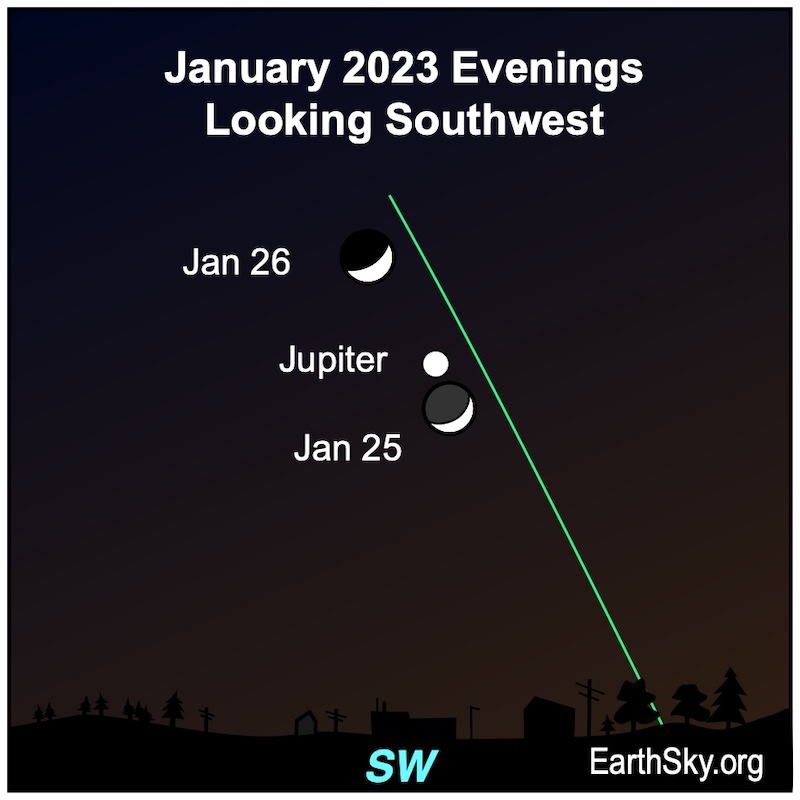
Our charts are mostly set for the northern half of Earth. In order to see a precise view from your location, try Stellarium Online.
Waxing crescent moon near Jupiter
You can’t miss Jupiter near the moon on the evenings of January 25 and 26, 2023!
Jupiter is the largest planet in our solar system. It reached opposition – when Earth flew between Jupiter and the sun – on last September 26. While it’s not as bright now as it was then, it still outshines the brightest stars at -2.1 magnitude.
Both the moon and Jupiter are in the constellation Pisces the Fish. But you’ll need a dark sky to see the faint stars of Pisces.
The moon and the planets
On January 25, the moon is a thickening waxing crescent that sets after 10 p.m. local time. The next night, a fatter waxing crescent moon is still close to Jupiter and sets around 11 p.m. local time.
As a side note, the moon reaches 1st quarter at 15:19 UTC (9:19 a.m. CST) on January 28, 2023. The 1st quarter moon rises at noon and sets about midnight.
So if you follow the moon from night to night, you’ll see it frequently pass by the planets in our solar system. For instance, the waning gibbous moon will be very close to Mars on January 31, 2023.
As a matter of fact, three other planets are in the January evening sky. First, look for bright Venus and Saturn near each other over the western horizon as dusk turns to darkness. However, Saturn may be difficult to spot in the evening twilight. And then Mars is high in the sky in the constellation of Taurus the Bull.
Bottom line: No matter where you are on the Earth, let the waxing crescent moon be your guide to the dazzling planet Jupiter on the evenings of January 25 and 26, 2023.
For more great observing events in the coming weeks, visit EarthSky’s night sky guide
The post Moon near Jupiter January 25 and 26 first appeared on EarthSky.
from EarthSky https://ift.tt/R9ag3nc

Our charts are mostly set for the northern half of Earth. In order to see a precise view from your location, try Stellarium Online.
Waxing crescent moon near Jupiter
You can’t miss Jupiter near the moon on the evenings of January 25 and 26, 2023!
Jupiter is the largest planet in our solar system. It reached opposition – when Earth flew between Jupiter and the sun – on last September 26. While it’s not as bright now as it was then, it still outshines the brightest stars at -2.1 magnitude.
Both the moon and Jupiter are in the constellation Pisces the Fish. But you’ll need a dark sky to see the faint stars of Pisces.
The moon and the planets
On January 25, the moon is a thickening waxing crescent that sets after 10 p.m. local time. The next night, a fatter waxing crescent moon is still close to Jupiter and sets around 11 p.m. local time.
As a side note, the moon reaches 1st quarter at 15:19 UTC (9:19 a.m. CST) on January 28, 2023. The 1st quarter moon rises at noon and sets about midnight.
So if you follow the moon from night to night, you’ll see it frequently pass by the planets in our solar system. For instance, the waning gibbous moon will be very close to Mars on January 31, 2023.
As a matter of fact, three other planets are in the January evening sky. First, look for bright Venus and Saturn near each other over the western horizon as dusk turns to darkness. However, Saturn may be difficult to spot in the evening twilight. And then Mars is high in the sky in the constellation of Taurus the Bull.
Bottom line: No matter where you are on the Earth, let the waxing crescent moon be your guide to the dazzling planet Jupiter on the evenings of January 25 and 26, 2023.
For more great observing events in the coming weeks, visit EarthSky’s night sky guide
The post Moon near Jupiter January 25 and 26 first appeared on EarthSky.
from EarthSky https://ift.tt/R9ag3nc

Aucun commentaire:
Enregistrer un commentaire